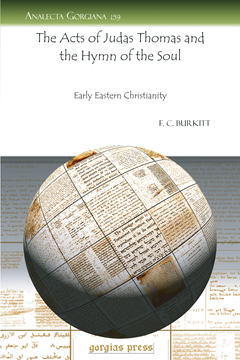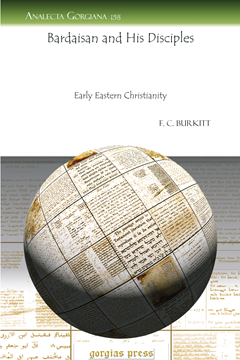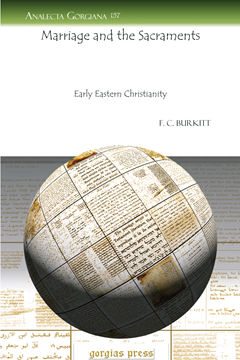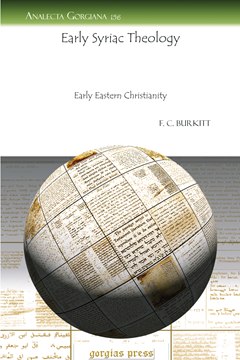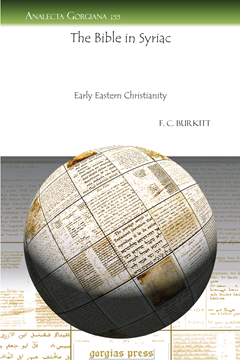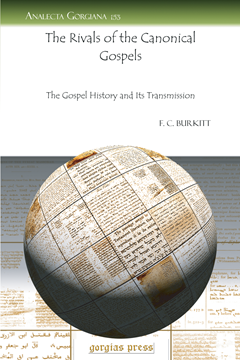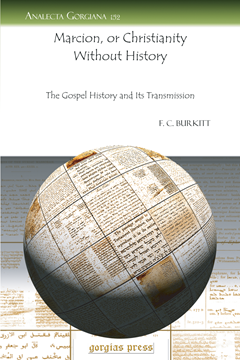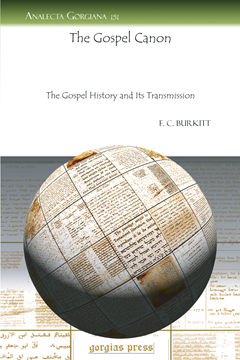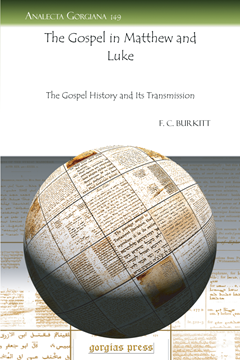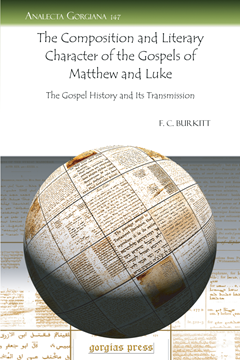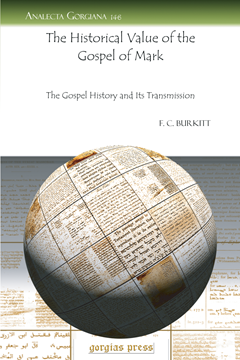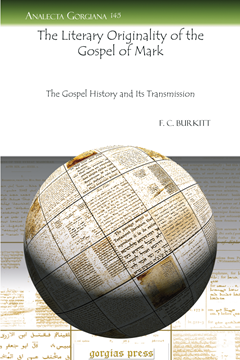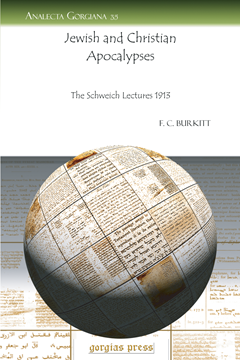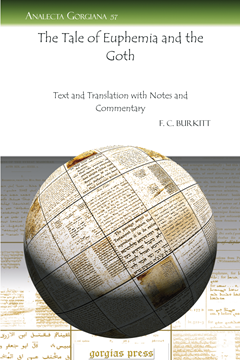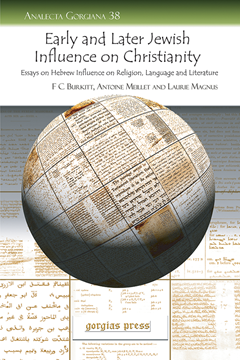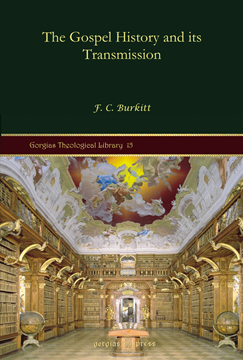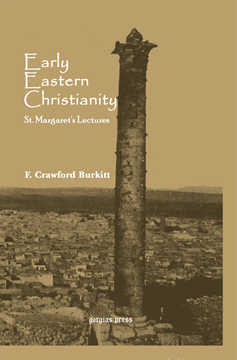Recently viewed products
F. Crawford Burkitt
The Syriac Forms of New Testament Proper Names
Series: Analecta Gorgiana 894
ISBN: 978-1-61143-469-9
Argument by the Norris Professor of Divinity at Cambridge that the spelling of the Syriac version of the Gospels should not be taken as authority for the original Aramaic names.
$38.00 (USD)
The Acts of Judas Thomas and the Hymn of the Soul
Early Eastern Christianity
Series: Analecta Gorgiana 159
ISBN: 978-1-60724-136-2
Originally delivered as one of the St. Margaret’s Lectures for 1904, the contents of this booklet are focused on aspects of the Syriac-speaking Church. Extracted from Burkitt’s book Early Eastern Christianity, the sixth lecture examines the ancient Syriac novel, The Acts of Judas Thomas. Embedded within that story is a Gnostic Hymn of the Soul, to which Burkitt pays special regard.
$39.00 (USD)
Bardaisan and His Disciples
Early Eastern Christianity
Series: Analecta Gorgiana 158
ISBN: 978-1-60724-130-0
Originally delivered as one of the St. Margaret’s Lectures for 1904, the contents of this booklet are focused on aspects of the Syriac-speaking Church. Extracted from Burkitt’s book Early Eastern Christianity, the fifth lecture explores Bardaisan and his unique contribution to Syriac Christianity.
$41.00 (USD)
Marriage and the Sacraments
Early Eastern Christianity
Series: Analecta Gorgiana 157
ISBN: 978-1-60724-129-4
Originally delivered as one of the St. Margaret’s Lectures for 1904, the contents of this booklet are focused on aspects of the Syriac-speaking Church. Extracted from Burkitt’s book Early Eastern Christianity, the fourth lecture concerns the development of marriage and the role of sacraments in the early Syriac Church. Burkitt finds that marriage was not early regarded as a sacrament and the married faithful were not permitted the sacraments of baptism or communion in the early tradition represented by Aphraates.
$39.00 (USD)
Early Syriac Theology
Early Eastern Christianity
Series: Analecta Gorgiana 156
ISBN: 978-1-60724-126-3
Originally delivered as one of the St. Margaret’s Lectures for 1904, the contents of this booklet are focused on aspects of the Syriac-speaking Church. Extracted from Burkitt’s book Early Eastern Christianity, the third lecture concerns the theology of Eastern Christianity. Burkitt provides a brief survey of the work of Aphraates, Philoxenus of Mabbug, Ephraim the Syrian, and Rabbula.
$41.00 (USD)
The Bible in Syriac
Early Eastern Christianity
Series: Analecta Gorgiana 155
ISBN: 978-1-60724-125-6
Originally delivered as one of the St. Margaret’s Lectures for 1904, the contents of this booklet are focused on aspects of the Syriac-speaking Church. Extracted from Burkitt’s book Early Eastern Christianity, the second lecture proposes a theory of how the Syriac Bible was compiled. Burkitt considers the role of the Peshitta, the Diatessaron, and the four Gospels and how their history at Edessa suggests that the Syriac Bible appeared.
$41.00 (USD)
The Early Bishops of Edessa
Early Eastern Christianity
Series: Analecta Gorgiana 154
ISBN: 978-1-60724-123-2
Originally delivered as one of the St. Margaret’s Lectures for 1904, the contents of this booklet are focused on aspects of the Syriac-speaking Church. Extracted from Burkitt’s book Early Eastern Christianity, the first lecture concerns the early bishops of Edessa. Starting from the basic difference between Eastern and Western Christian outlooks, Burkitt briefly sketches the early history of documented Edessa. Christianity appeared in the city between its sacking by the Romans and its incorporation into the Roman Empire around the start of the third century A.D.
$32.80 (USD)
The Rivals of the Canonical Gospels
The Gospel History and Its Transmission
Series: Analecta Gorgiana 153
ISBN: 978-1-60724-122-5
Originally delivered as one of the Jowett Lectures for 1906, the contents of this booklet emerged during the first quest for the historical Jesus. Somewhat surprisingly, Burkitt discovered that historical criticism increased the historical credibility of the Synoptic Gospels in his estimation. This ninth lecture in the series concerns itself with the non-canonical, or apocryphal gospels. Written before the discovery of the Nag-Hammadi library, this study considers the Testamentum Domini, Pistis Sophia, the Gospel and Apocalypse of St. Peter, the Protevangelium of James, the Infancy Gospel of Thomas, the Gospel According to the Hebrews, and the Oxyrhynchus Logia..
$37.00 (USD)
Marcion, or Christianity Without History
The Gospel History and Its Transmission
Series: Analecta Gorgiana 152
ISBN: 978-1-60724-121-8
Originally delivered as one of the Jowett Lectures for 1906, the contents of this booklet emerged during the first quest for the historical Jesus. Somewhat surprisingly, Burkitt discovered that historical criticism increased the historical credibility of the Synoptic Gospels in his estimation. This eighth lecture in the series addresses Marcion. Burkitt focuses on how this early Christian thinker remained ahead of his time while also falling out of the mainstream of what was an emerging Christianity.
$39.00 (USD)
The Gospel Canon
The Gospel History and Its Transmission
Series: Analecta Gorgiana 151
ISBN: 978-1-60724-120-1
Originally delivered as one of the Jowett Lectures for 1906, the contents of this booklet emerged during the first quest for the historical Jesus. Somewhat surprisingly, Burkitt discovered that historical criticism increased the historical credibility of the Synoptic Gospels in his estimation. This seventh lecture in the series traces the origin of the authoritative four-fold Gospels to about 150 of the Common Era when they are amply attested together. Positing a three-stage evolution to the canonical Gospels, Burkitt notes that other Gospels did not measure up to the same standard.
$38.00 (USD)
The Fourth Gospel
The Gospel History and Its Transmission
Series: Analecta Gorgiana 150
ISBN: 978-1-60724-119-5
Originally delivered as one of the Jowett Lectures for 1906, the contents of this booklet emerged during the first quest for the historical Jesus. Somewhat surprisingly, Burkitt discovered that historical criticism increased the historical credibility of the Synoptic Gospels in his estimation. This sixth lecture in the series turns to the Gospel of John. Burkitt addresses the enduring questions of authorship and historicity, comparing the Gospel of John to the Synoptics, Philo, the Gnostics, and the Stoics.
$41.00 (USD)
The Gospel in Matthew and Luke
The Gospel History and Its Transmission
Series: Analecta Gorgiana 149
ISBN: 978-1-60724-118-8
Originally delivered as one of the Jowett Lectures for 1906, the contents of this booklet emerged during the first quest for the historical Jesus. Somewhat surprisingly, Burkitt discovered that historical criticism increased the historical credibility of the Synoptic Gospels in his estimation. This fifth lecture in the series examines the concept of gospel in Matthew and Luke. Burkitt notes the special emphases and concerns of these two Gospel writers, calling attention to how they differ from each other and also from Mark.
$38.00 (USD)
The Teaching of Jesus Christ
The Gospel History and Its Transmission
Series: Analecta Gorgiana 148
ISBN: 978-1-60724-117-1
Originally delivered as one of the Jowett Lectures for 1906, the contents of this booklet emerged during the first quest for the historical Jesus. Somewhat surprisingly, Burkitt discovered that historical criticism increased the historical credibility of the Synoptic Gospels in his estimation. This fourth lecture in the series begins by noting that in early Christianity it was Jesus that was preached and not Jesus’ sayings. Burkitt thus suggests some criteria for finding Jesus’ original words and then applies them in order to reconstruct the teachings of Jesus.
$41.00 (USD)
The Composition and Literary Character of the Gospels of Matthew and Luke
The Gospel History and Its Transmission
Series: Analecta Gorgiana 147
ISBN: 978-1-60724-116-4
Originally delivered as one of the Jowett Lectures for 1906, the contents of this booklet emerged during the first quest for the historical Jesus. Somewhat surprisingly, Burkitt discovered that historical criticism increased the historical credibility of the Synoptic Gospels in his estimation. This third lecture in the series addresses the composition and literary characteristics of the Gospels of Matthew and Luke.
$38.00 (USD)
The Historical Value of the Gospel of Mark
The Gospel History and Its Transmission
Series: Analecta Gorgiana 146
ISBN: 978-1-60724-115-7
Originally delivered as one of the Jowett Lectures for 1906, the contents of this booklet emerged during the first quest for the historical Jesus. Somewhat surprisingly, Burkitt discovered that historical criticism increased the historical credibility of the Synoptic Gospels in his estimation. This second lecture in the series addresses the historical value of the Gospel of Mark. Here Burkitt considers the historical questions of how accurately Mark may portray his limited life of Jesus.
$39.00 (USD)
The Literary Originality of the Gospel of Mark
The Gospel History and Its Transmission
Series: Analecta Gorgiana 145
ISBN: 978-1-60724-114-0
Originally delivered as one of the Jowett Lectures for 1906, the contents of this booklet emerged during the first quest for the historical Jesus. Somewhat surprisingly, Burkitt discovered that historical criticism increased the historical credibility of the Synoptic Gospels in his estimation. This first lecture in the series addresses the literary originality of the Gospel of Mark. Here Burkitt surveys the priority of Mark, the shared Synoptic material, and the literarily unique sections of Mark.
$36.00 (USD)
Jewish and Christian Apocalypses
The Schweich Lectures 1913
Series: Analecta Gorgiana 35
ISBN: 978-1-59333-664-6
In this time of intense apocalyptic interests, Burkitt’s study of extra-biblical apocalypses will shed some light. Burkitt is known for his work in early Christianity, and he is well-equipped to deal with this difficult issue. These Schweich Lectures of 1913 address the book of Enoch, minor Jewish and early Christian apocalypses, especially the Ascension of Isaiah.
$51.00 (USD)
The Early Syriac Lectionary
Series: Analecta Gorgiana 62
ISBN: 978-1-59333-878-7
This piece provides an introduction, translation and commentary to a previously unstudied lectionary text, which provides deeper insight into early liturgical practice and the conception of the canon; and includes an index of the lessons according to books of Scripture.
$41.00 (USD)
Shmona, Guria and Habib Edessan Martyrs
Texts and Translations with Notes and Commentary
Series: Analecta Gorgiana 58
ISBN: 978-1-59333-873-2
In this book the Syriac texts along with translations of the tales of the martyrs are introduced by Professor Burkitt with a commentary focusing on the historicity of the different accounts.
$71.00 (USD)
The Tale of Euphemia and the Goth
Text and Translation with Notes and Commentary
Series: Analecta Gorgiana 57
ISBN: 978-1-59333-876-3
This book provides the Syriac text along with a translation of the tale of Euphemia and the martyrs’ deliverance of her from the Goth.
$56.00 (USD)
The Acts of the Edessan Martyrs Guria and Shmona, and Habib and the Story of their Deliverance of Eu
ISBN: 978-1-59333-872-5
In this book the Syriac texts along with translations of the tales of the martyrs themselves as well as the miraculous deliverance of Euphemia are introduced by Professor Burkitt with a commentary focusing on the historicity of the different accounts.
$151.00 (USD)
Early and Later Jewish Influence on Christianity
Essays on Hebrew Influence on Religion, Language and Literature
Series: Analecta Gorgiana 38
ISBN: 978-1-59333-692-9
Selected from the essays of the influential volume “The Legacy of Israel,” the three contributions in this volume explore early and later Jewish influence on Christianity. Written by F. C. Burkitt, A. Meillet, and L. Magnus, the articles consider the patristic period and modern European literary usage of Hebrew scripture and tradition.
$48.00 (USD)
The Gospel History and its Transmission
Series: Kiraz Theological Archive 15
ISBN: 978-1-59333-529-8
The essays in this informative book were originally delivered as the Jowett Lectures for 1906. They address many critical issues regarding the historical veracity of the Gospels and represent the emerging interest in the historical Jesus that was the spirit of the times. Besides addressing the canonical Gospels, this volume also discusses Marcion and non-canonical gospels.
$178.00 (USD)
Saint Ephraim's Quotations From The Gospel
Series: Texts and Studies (First Series) Vol. 7, No. 2
ISBN: 1-59333-320-X
This book attempts to determine the Gospel text used by Ephraim, and the bearing his quotations have upon the date of the Peshitta. Ephraim is one of the figures from the Syriac-speaking Church whose name is well known in both East and West. His surviving works are by themselves as voluminous as all other remains of Syriac literature earlier than 400 AD. Ephraim’s death in roughly 373 AD means that his Gospel text predates the 5th century and attests a text older than many of the extant manuscripts.
$111.00 (USD)
Early Eastern Christianity
St. Margaret's Lectures
ISBN: 1-59333-101-0
Contains six lectures: early bishops of Edessa, Bible in Syriac, early Syriac theology, marriage and the sacraments, Bardaisan and his disciples, Acts of Judas Thomas, and Hymn of the Soul. They were delivered in 1904 by Burkitt, then lecturer in paleography, at the University of Cambridge.
$146.00 (USD)
- 1
- 2



